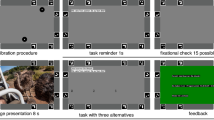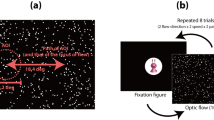Abstract
We investigated how the influence of natural exploratory gaze behaviour on postural control develops from childhood into adulthood. In a cross-sectional design, we compared four age groups: 6-, 9-, 12-year-olds and young adults. Two experimental trials were performed: quiet stance with a fixed gaze (fixed) and quiet stance with natural exploratory gaze behaviour (exploratory). The latter was elicited by having participants watch an animated short film on a large screen in front of them. 3D head rotations in space and centre of pressure (COP) excursions on the ground plane were measured. Across conditions, both head rotation and COP displacement decreased with increasing age. Head movement was greater in the exploratory condition in all age groups. In all children—but not in adults—COP displacement was markedly greater in the exploratory condition. Bivariate correlations across groups showed highly significant positive correlations between COP displacement in ML direction and head rotation in yaw, roll, and pitch in both conditions. The regularity of COP displacements did not show a clear developmental trend, which indicates that COP dynamics were qualitatively similar across age groups. Together, the results suggest that the contribution of head movement to eye-head saccades decreases with age and that head instability—in part resulting from such gaze-related head movements—is an important limiting factor in children’s postural control. The lack of head stabilisation might particularly affect children in everyday activities in which both postural control and visual exploration are required.



Similar content being viewed by others
References
Asai H, Aoki J (1996) Force development of dynamic and static contractions in children and adults. Int J Sports Med 17(3):170–174
Assaiante C, Amblard B (1995) An ontogenic model for the sensorimotor organization of balance control in humans. Hum Mov Sci 14(1):13–43
Bertenthal BI, Boker SM, Xu M (2000) Analysis of the perception-action cycle for visually induced postural sway in 9-month-old sitting infants. Infant Behav Dev 23(3–4):299–315
Bonnet CT, Despretz P (2012) Large lateral head movements and postural control. Hum Mov Sci 31(6):1541–1551
Bunge SA, Dudukovic NM, Thomason ME, Vaidya CJ, Gabrieli JDE (2002) Immature frontal lobe contributions to cognitive control in children: evidence from fMRI. Neuron 33(2):301–311
Chen LC, Metcalfe JS, Chang TY, Jeka JJ, Clark JE (2008) The development of infant upright posture: sway less or sway differently? Exp Brain Res 186(2):293–303
Crawford JD, Guitton D (1997) Primate head-free saccade generator implements a desired (post-VOR) eye position command by anticipating intended head motion. J Neurophysiol 78(5):2811–2816
Donker SF, Roerdink M, Greven AJ, Beek PJ (2007) Regularity of center-of-pressure trajectories depends on the amount of attention invested in postural control. Exp Brain Res 181(1):1–11
Ferber-Viart C, Ionescu E, Morlet T, Froehlich P, Dubreuil C (2007) Balance in healthy individuals assessed with Equitest: maturation and normative data for children and young adults. Int J Pediatr Otorhinolaryngol 71(7):1041–1046
Giveans MR, Yoshida K, Bardy B, Riley M, Stoffregen TA (2011) Postural sway and the amplitude of horizontal eye movements. Ecol Psychol 23(4):247–266
Goldberger AL, Amaral LAN, Glass L, Hausdorff JM, Ivanov PC, Mark RG, Mietus JE, Moody GB, Peng CK, Stanley HE (2000) PhysioBank, PhysioToolkit, and PhysioNet—components of a new research resource for complex physiologic signals. Circulation 101(23):E215–E220
Lake DE, Richman JS, Griffin MP, Moorman JR (2002) Sample entropy analysis of neonatal heart rate variability. Am J Physiol Regul Integr Comp Physiol 283(3):R789–R797
Mallau S, Vaugoyeau M, Assaiante C (2010) Postural strategies and sensory integration: no turning point between childhood and adolescence. Plos One 5(9):e13078
Menz HB, Lord SR, Fitzpatrick RC (2003a) Acceleration patterns of the head and pelvis when walking are associated with risk of falling in community-dwelling older people. J Gerontol A Biol 58(5):446–452
Menz HB, Lord SR, Fitzpatrick RC (2003b) Acceleration patterns of the head and pelvis when walking on level and irregular surfaces. Gait Posture 18(1):35–46
Murray K, Lillakas L, Weber R, Moore S, Irving E (2007) Development of head movement propensity in 4–15 year old children in response to visual step stimuli. Exp Brain Res 177(1):15–20
O’Leary DS (1990) Neuropsychological development in the child and the adolescent: functional maturation of the central nervous system. In: Hauert C (ed) Advances in psychology, vol 64. North-Holland, Amsterdam, pp 339–355
Oommen BS, Stahl JS (2005) Overlapping gaze shifts reveal timing of an eye-head gate. Exp Brain Res 167(2):276–286
Oommen BS, Smith RM, Stahl JS (2004) The influence of future gaze orientation upon eye-head coupling during saccades. Exp Brain Res 155(1):9–18
Peterson ML, Christou E, Rosengren KS (2006) Children achieve adult-like sensory integration during stance at 12-years-old. Gait Posture 23(4):455–463
Pozzo T, Berthoz A, Lefort L (1990) Head stabilization during various locomotor tasks in humans. 1. Normal subjects. Exp Brain Res 82(1):97–106
Pozzo T, Levik Y, Berthoz A (1995) Head and trunk movements in the frontal plane during complex dynamic equilibrium tasks in humans. Exp Brain Res 106(2):327–338
Regal DM, Ashmead DH, Salapatek P (1983) The coordination of eye and head movements during early infancy: a selective review. Behav Brain Res 10(1):125–132
Richman JS, Moorman JR (2000) Physiological time-series analysis using approximate entropy and sample entropy. Am J Physiol Heart Circ Physiol 278(6):H2039–H2049
Saldanha C (2002) Gone nutty [animated short film]. 20th Century Fox, USA
Schärli AM, van de Langenberg R, Murer K, Müller RM (2012) The influence of gaze behaviour on postural control from early childhood into adulthood. Gait Posture 36(1):78–84
Slobounov SM, Newell KM, Larry RS (2009) Balance and posture control: human. In: Binder MD, Hirokawa N, Windhorst U (eds) Encyclopedia of neuroscience. Academic Press, Oxford, pp 31–35
Stahl JS (1999) Amplitude of human head movements associated with horizontal saccades. Exp Brain Res 126(1):41–54
Thumser ZC, Adams NL, Lerner AJ, Stahl JS (2010) Probing the mechanism of saccade-associated head movements through observations of head movement propensity and cognition in the elderly. Exp Brain Res 202(4):903–913
Waite TA, Campbell LG (2006) Controlling the false discovery rate and increasing statistical power in ecological studies. Ecoscience 13:439–442
Wu G (2001) Head movement during sudden base translations as a measure of risks for falls in the elderly. Clin Biomech 16(3):199–206
Acknowledgments
The authors are thankful for the support of the primary school Schwerzenbach (Switzerland) that allowed us to conduct the experiment in one of their classrooms and with their pupils. We would also like to thank all the children and adults that participated in the study and Giuseppe Pichierri for the preparation of Fig. 1.
Conflict of interest
The authors declare that they have no conflict of interest.
Author information
Authors and Affiliations
Corresponding author
Rights and permissions
About this article
Cite this article
Schärli, A.M., van de Langenberg, R., Murer, K. et al. Postural control and head stability during natural gaze behaviour in 6- to 12-year-old children. Exp Brain Res 227, 523–534 (2013). https://doi.org/10.1007/s00221-013-3528-y
Received:
Accepted:
Published:
Issue Date:
DOI: https://doi.org/10.1007/s00221-013-3528-y




